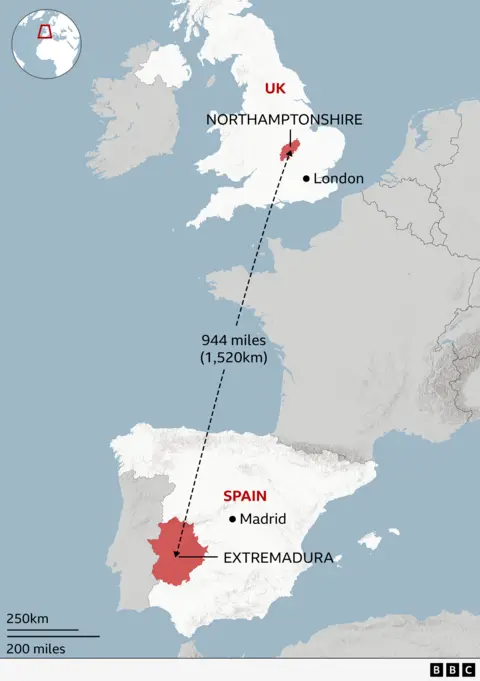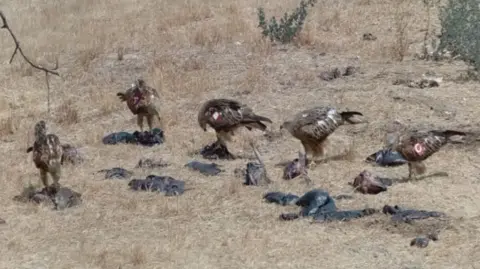Katharine Da CostaSouth of England
A British red kite emerged from an aviary in the remote hills of western Spain and took flight. At six months old, this is the first taste of freedom.
Without a sound, it glided through the sky above the scrubland and within seconds disappeared from a wooded valley in the distance.
This is the latest release in a conservation story that has come full circle.
Almost four decades ago, the birds disappeared from England and Scotland with only a few pairs remaining in Wales.
In the late 1980s and early 1990s, red kite chicks from Spain and Sweden were released in the Chilterns on the Oxfordshire-Buckinghamshire border.
It has been so successful that the species is now thriving in the UK, with estimates of more than 6,000 breeding pairs or about 15% of the world’s population.
Dr Ian Evans, originally from England, was one of the early pioneers.
He said: “There are a lot of unknowns. The first part we released, we thought they might just die or they might just run away.
“In 1991, we had our first breeding pairs and that was an eye-opener because we thought ‘well, this can be successful’.
“That will be the springboard for establishing other release sites in England and Scotland.”
 Ian Evans
Ian EvansBritish-born red kites have been brought to South West Spain as part of a four-year project to revive the population there from extinction.
The region has less than 50 pairs due to predators such as the Eagle Owl and human factors such as illegal poisoning and electrocution.
In 2022, the conservationists granted special licenses from natural England To collect red chicks, mostly from Northamptonshire, and send them to the extremadura region of Spain.
More than 120 chicks are collected, with about 30 exported each year.
 Simon Dudhill
Simon DudhillAbout the red kite
- It is one of Britain’s largest birds of prey, known for its reddish-brown body, long wings, forked tail and distinctive “mewing” calls.
- Once considered a threat to game and domestic animals such as cats and dogs, the red kite was hunted in the UK and at one point there were only a few in central Wales.
- Red Kites are mostly scavengers, feeding on Carrion and Small Prey like rabbits
- The birds are endemic to Europe and are endangered due to illegal persecution by shooting, poisoning and trapping

The chicks were flown to Madrid and then taken 240 miles (385Km) south to the Wildlife Hospital in Villafranca de Los Barros, run by Accion Por El Mundo Salvaje (boss).
When I arrived, the small team, led by Ornithologist and Project Manager Alfonso Godino, was hard at work.
Each chicken must be weighed, measured and tagged before being placed in a GPS backpack that allows experts to track it.
The birds look lifeless as they are manipulated into position. Mr. Godino told me that they have a dead body that they feel is not a threat.
Asked if the tagging hurts, he says it’s a minor irritation, like a tear in your ears.
Alfonso said the juveniles soon became accustomed to multiple tags, which were necessary to observe them from the ground.
The birds were then transferred to holding aviaries near the Portuguese border for two weeks to acclimate to their new environment.
The release site is quiet and secluded. There is a strong smell of rotting flesh coming from the body of a sheep left behind to attract red cats to feed here.
As the gate was removed, I expected the chicks to rush but, except for a few flutters inside the aviary, nothing happened.
It takes a lot of time, as they build up courage, before one they leave the safety of the aviary behind and fly into the wild.
‘Bittersweet Moment’
“Now is the exciting moment when they are in the wild, they will learn to find food, to avoid predators, to communicate with the GPS that we monitor these birds that we release,” Alfonso told me.
But it was a nerve-racking hour for amus field technician Sofia Marrero.
“Mortality for raptors in general is very high in the first years of their lives,” he said. “So now it’s very little because you know some of them may not make it to adulthood, so it’s a little bittersweet.”
In fact, only about a quarter of the red kittens released during the project survived.
The biggest threats come from predators and natural causes.
By 2023, Eagle Owls will be responsible for killing half of the newly released red chicks of the red project.
In response, the Amus team adapted how and when the chicks were released to increase their chances of survival.
 Sebastien Crs, Amus
Sebastien Crs, AmusMuch work has also been done to align thousands of kilometers of cables to reduce the risk of electrocution.
But the biggest danger to humans in birds of prey comes from illegal poisoning.
Between 2020-2024, 3,060 red kittens will be tagged and entered with GPS as part of Project of Eurokite in LifeSpanning 40 project areas in 12 countries.
By September 2024, 1,377 tagged red kittens had died – 622 from natural causes, including predation, while 195 died from digging and 54 from illegal shooting.
Experts say the numbers represent only the “tip of the iceberg” in terms of illegal persecution.
In the UK, the RSPB works with European partners to provide advice on how to investigate poisoning cases.
A report by the charity last year revealed at least 1,344 birds of prey were killed in the UK between 2009 and 2023.
“The persecution of the raptor is directly linked to the expats of the game to the plains of Pheasant and Partridge and the Upland Grouse,” Mark Thomas, the head of the investigation of the RSPB in the RSPB in the RSPB.
“All the statistics prove that … two thirds of all convictions for gamekeepers are people fixing games they can control,” he added.
The charity believes that the toy licensing estates will change the issue but that the Alliance of Cyberspace is trusted.
In a statement, the non-profit organization said: “Any event of persecution of the raptor is fully condemned, with penalties including a prison sentence with an unlimited fine.”
 boss
bossIn Spain, the extremadura relocation project has seen three pairs wake up so far with two life-saving chicks.
With more red-tagged kittens due to reach sexual maturity next year, these numbers are expected to increase.
“There are still many places in southern Spain where the red kite was common three decades ago and now it is almost extinct,” said Mr. Godino.
“So the next step is how we can use this experience in other areas of Spain.”


